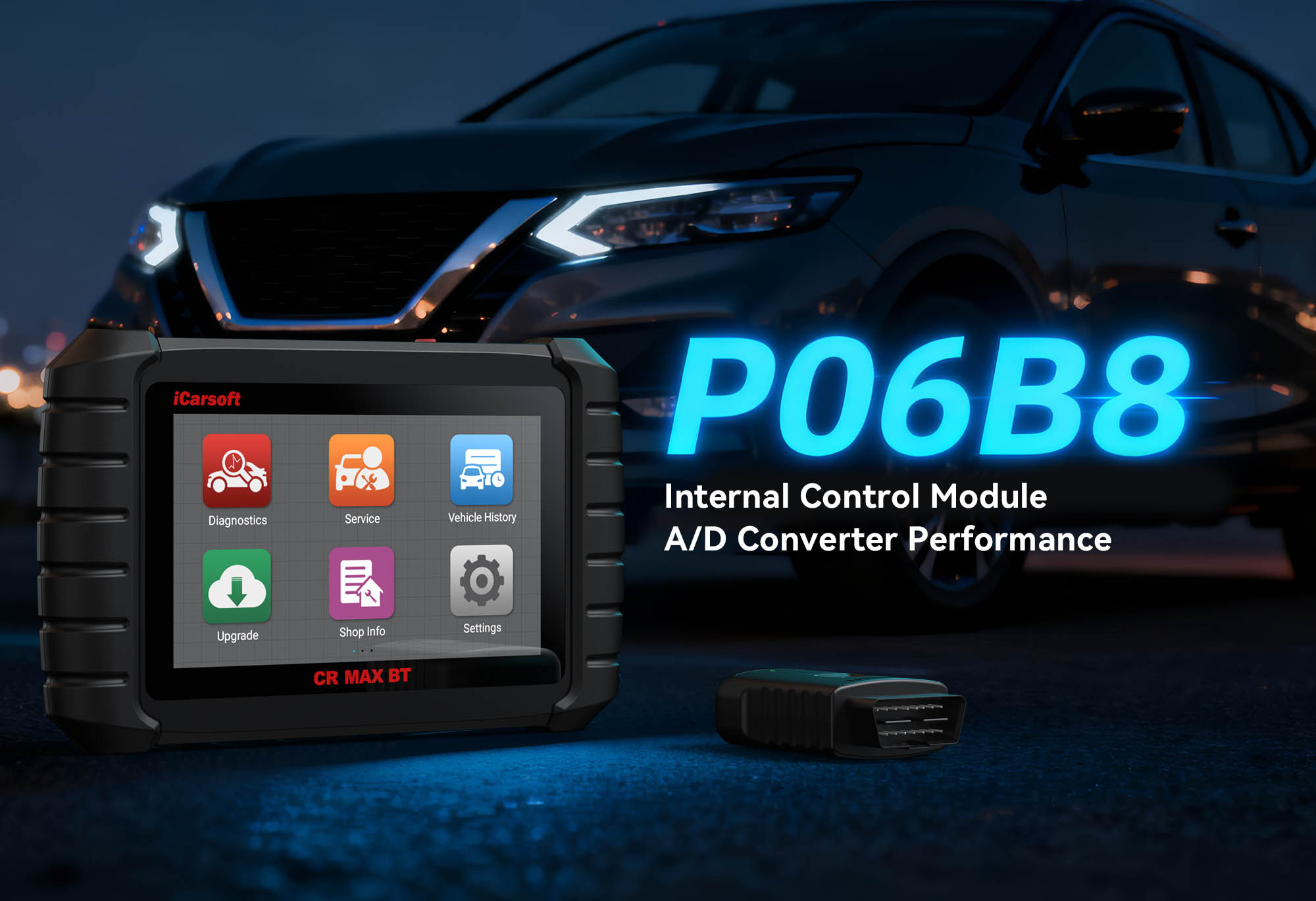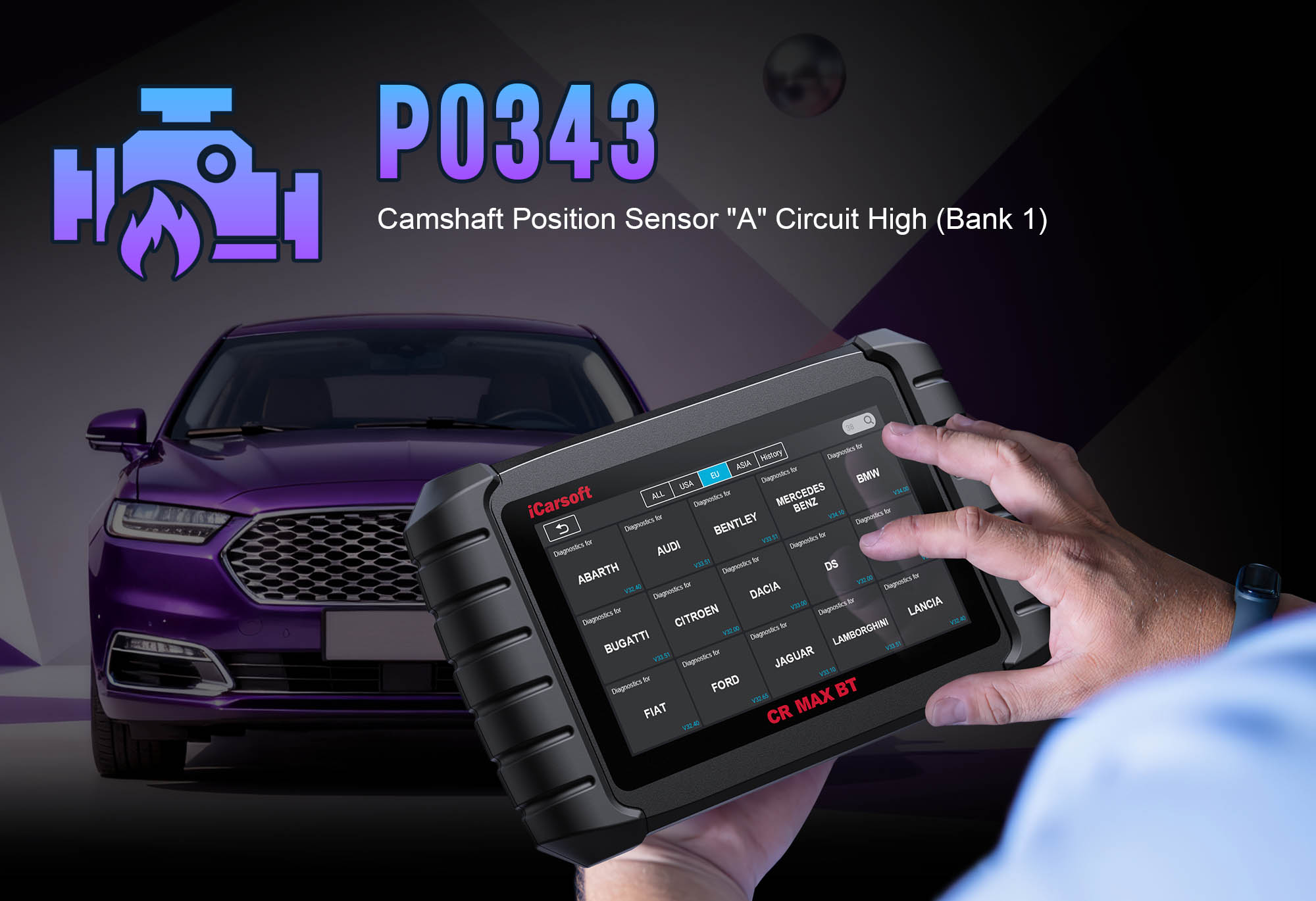Understand & Fix P0198: Engine Oil Temperature Sensor Circuit High Input with iCarsoft CR Ultra P
If your vehicle’s check engine light turns on, you notice erratic oil pressure readings, or experience overheating, a diagnostic scan will likely return P0198. This OBD-II code stands for "Engine Oil Temperature (EOT) Sensor Circuit High Input"—a critical fault targeting the EOT sensor and its control circuit. The EOT sensor monitors the temperature of engine oil, sending real-time data to the Engine Control Module (ECM) to adjust oil pressure, cooling system operation, and fuel injection. A "high input" error means the ECM detects a voltage signal above the normal range (typically 4.5V–5V), indicating the sensor or circuit isn’t providing accurate temperature data.
Basic scanners might only flag an "oil system error" but can’t measure sensor voltage, test circuit continuity, or validate sensor responsiveness—leaving you guessing between a faulty EOT sensor, damaged wiring, or a shorted circuit. The iCarsoft CR Ultra P, with its OE-level engine diagnostics, bi-directional control, and live data tracking, solves this. Below, we break down P0198, its causes, symptoms, step-by-step resolution, and 8 FAQs to answer common troubleshooting questions.
What Is P0198?
P0198 focuses on the engine oil temperature sensor—a thermistor-based component typically located in the oil pan, oil filter housing, or cylinder head. The EOT sensor changes resistance with temperature: cold oil increases resistance (lower voltage, ~0.5V), while hot oil decreases resistance (higher voltage, ~4.0V). When the signal exceeds the ECM’s upper threshold (often 4.5V), the module triggers P0198. This high input usually stems from a shorted sensor, damaged wiring, or a malfunctioning EOT—all of which prevent the ECM from optimizing oil system performance and engine protection.
Key Symptoms of P0198
-
Illuminated Check Engine Light: The primary warning sign, often paired with codes like P0520 (oil pressure sensor circuit malfunction) or P0128 (coolant temperature below thermostat regulating temperature).
-
Erratic Oil Pressure Readings: False "hot oil" signals (high voltage) prompt the ECM to adjust oil pressure incorrectly, leading to fluctuating gauge readings.
-
Engine Overheating Risk: Inaccurate EOT data disrupts the cooling system’s operation, as the ECM may not engage the radiator fan when needed.
-
Reduced Engine Power: The ECM may enter "limp mode" to protect the engine from potential damage due to unmonitored oil temperature.
-
Poor Fuel Economy: Hot oil misreads can cause the ECM to adjust fuel injection for "high-load" conditions, increasing fuel consumption.
-
Oil Warning Light Activation: Extreme false temperature readings may trigger the oil pressure or overheating warning light on the dashboard.
Common Causes of P0198
|
Cause
|
Description
|
|
Faulty EOT Sensor
|
A shorted or worn thermistor in the EOT sensor sends a constant high-voltage signal to the ECM.
|
|
Wiring/Circuit Issues
|
Frayed wires, corroded connectors, or a short circuit between the EOT sensor and the vehicle’s 12V power supply.
|
|
Blown Fuse or Faulty Relay
|
A damaged fuse/relay in the engine sensor circuit disrupts voltage regulation, leading to signal spikes.
|
|
Oil Contamination
|
Sludge, metal particles, or coolant in the oil can damage the EOT sensor’s thermistor.
|
|
ECM Malfunction
|
Rarely, the ECM’s internal circuit for processing EOT data fails, misinterpreting normal signals as "high input."
|
Why iCarsoft CR Ultra P Excels at Diagnosing P0198
The CR Ultra P outperforms basic tools with features tailored to engine oil temperature sensor and circuit diagnostics:
Real-Time EOT Voltage Tracking
Monitors the sensor’s voltage signal, highlighting spikes above the 4.5V threshold that trigger P0198.
Bi-Directional EOT Testing
Sends voltage commands to the sensor to verify responsiveness, distinguishing EOT faults from wiring issues.
Circuit Integrity Checks
Uses built-in multimeter functions to test for shorts, opens, and continuity in the EOT wiring.
Topology Mapping
Visualizes the engine’s sensor wiring and oil system components, making hidden damage easy to locate.
Global Vehicle Coverage
Supports 200+ passenger vehicle brands and 2018+ models with advanced engine management systems.
41 Hot Service Functions
Includes oil system reset, coolant bleeding, and EOT calibration—critical for post-repair validation.
Step-by-Step: Diagnose P0198 with iCarsoft CR Ultra P
-
Confirm P0198 & Gather Data
Plug the CR Ultra P into your vehicle’s OBD-II port, power on the tool, and select AutoVIN Identify to auto-detect your vehicle’s make, model, and engine configuration.
Navigate to Engine > Fault Codes > Read Codes to confirm P0198. Tap Code Details for model-specific insights (e.g., "Toyota Camry: Engine Oil Temperature Sensor Circuit High Input; Voltage: 4.9V, Expected: 0.5–4.0V; Check EOT Wiring or Sensor").
-
Analyze Live EOT & Engine Data
Go to Engine > Live Data > Engine Sensors and monitor three key metrics:
1. EOT Sensor Voltage: Should fluctuate between 0.5V (cold oil) and 4.0V (hot oil). A fixed reading above 4.5V confirms P0198.
2. EOT Reading: The CR Ultra P converts voltage to temperature (e.g., 0.5V = 32°F, 4.0V = 212°F). A reading above 250°F (121°C) with cold oil = high input fault.
3. Oil Pressure: Abnormal pressure (too high/low) may indicate a linked issue—use the CR Ultra P’s Oil Pressure Test to verify specs.
-
Test the Engine Oil Temperature Sensor (EOT)
1. Use Bi-Directional Control > Engine > EOT Sensor Test: Send voltage commands (e.g., 2.0V for 68°F) to the EOT sensor and check if the temperature reading updates. No change = faulty sensor.
2. Locate the EOT sensor: Use the CR Ultra P’s Component Location tool (typically in the oil filter housing or oil pan).
3. Inspect & Test: Check for corrosion, oil sludge, or loose connectors. Use the CR Ultra P’s Resistance Test to check the thermistor (should match OEM specs, e.g., 10k ohms at 68°F—0 ohms = short; infinite = open).
-
Inspect Wiring, Fuses, & Oil System
1. Wiring Check: Use Continuity Test to check EOT wiring for breaks. Look for frayed wires near the sensor or ECM connectors (pay close attention to areas near the engine block).
2. Fuse/Relay Check: Navigate to Vehicle > Fuse Box Diagram (via the CR Ultra P) to find engine sensor-related fuses/relays. Test for continuity with the tool’s multimeter—replace any blown fuses.
3. Oil System Check: Check oil level and condition. If oil is contaminated with coolant or sludge, perform an oil change before retesting the EOT sensor.
-
Repair & Clear the Code
- Replace the EOT sensor if tests confirm it’s faulty (use OEM-compatible sensors to ensure accurate temperature readings).
- Repair damaged wiring, replace blown fuses/relays, or service the oil system as needed.
- Use the CR Ultra P to Clear Codes and run an Engine System Validation Test (under Special Functions) to confirm P0198 is resolved. Monitor EOT voltage during a test drive to ensure it fluctuates with engine temperature.
FAQs: P0198 Troubleshooting
Can I drive with P0198?
Short trips (e.g., to a repair shop) are possible, but long-term driving risks engine overheating or oil system damage. Use the CR Ultra P to monitor EOT voltage—if it stays above 4.8V, avoid driving until repairs are done.
How much does it cost to fix P0198?
A new engine oil temperature sensor costs $30–$120, plus $80–$200 for labor (lower if the sensor is easily accessible, e.g., in the oil filter housing). Using the CR Ultra P to diagnose yourself saves on shop diagnostic fees ($100–$150).
Why does P0198 keep returning after clearing it?
The root cause wasn’t addressed. Common culprits: unaddressed wiring shorts (e.g., near the engine block), a faulty sensor relay, or oil contamination damaging the new sensor. Use the CR Ultra P’s History Log to track recurrence (e.g., after oil change = sludge-related damage).
Is P0198 caused by low oil level?
Indirectly—low oil can cause the sensor to overheat, but P0198 is strictly a voltage/circuit issue. Low oil typically triggers a separate "low oil level" warning, not a sensor circuit fault.
How do I distinguish between a faulty EOT sensor and wiring?
Use bi-directional testing: EOT doesn’t respond to voltage commands + high constant voltage = faulty EOT sensor; EOT doesn’t respond + voltage drops to normal when wiring is wiggled = wiring short/break.
Do I need to calibrate the EOT sensor after replacement?
Yes—use the CR Ultra P’s EOT Sensor Calibration (under Special Functions) to sync the new sensor with the ECM. This ensures the module recognizes the sensor’s voltage-temperature range.
Can extreme weather cause P0198?
Indirectly—cold weather can make wiring brittle (leading to breaks), while hot weather can accelerate sensor wear. Use the CR Ultra P’s Wiring Resistance Test to check for weather-related damage.
Will P0198 fail an emissions test?
It depends—if P0198 triggers limp mode or disrupts fuel injection, emissions may increase. Fix P0198 with the CR Ultra P, drive 50+ miles to reset readiness monitors, and retest to ensure compliance.
Conclusion
P0198’s engine oil temperature sensor high input fault threatens engine reliability and oil system performance. The iCarsoft CR Ultra P simplifies diagnosis with real-time voltage tracking, bi-directional tests, and system validation, ensuring you fix the root cause—not just the code.
With a 10.1-inch HD touchscreen, 12600mAh long-life battery, and 3 years of free software updates, the CR Ultra P is a must-have for DIYers and mechanics. Resolve P0198, protect your engine from overheating, and restore optimal performance—all with one professional-grade diagnostic scanner.





